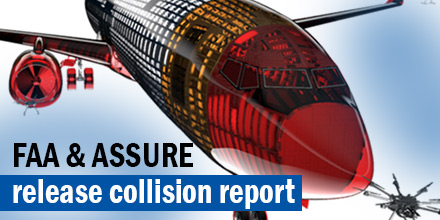
Last October, a research team from the Alliance for System Safety of UAS through Research Excellence (ASSURE) released a
report on airborne collisions.
At this time, the
Federal Aviation Administration (FAA) is yet to definitively address drone collision concerns.
Currently, several universities continue to conduct studies and collect data to help inform any future decisions by the FAA.
The report by ASSURE concludes that drones that collide with large manned aircraft can cause more structural damage than birds of the same weight for a given impact speed.
The FAA plans on using the research results to develop operational and collision risk mitigation requirements for drones.
Choosing the aircraft
The research team began the study in FY 2016. The focus of the study was simple, answer the question:
what happens when there is a collision between an sUAS and an airplane?
Researchers determined the most like impact scenarios by reviewing the operational environments of both sUAS and manned aircraft. Based on this evaluation, the team selected the business and commercial aircraft as well as the sUAS for computer modeling and physical validation testing.
The final selections included the characteristics of a Boeing B737 and an Airbus A320. These crafts represent 70% of today's commercial aircraft fleet. Characteristics of the Learjet 30/40/50 represented the business jet model.
For the sUAS, the team chose a small quadcopter as well as a light fixed-wing UAV.
Areas of a manned craft determined to most likely experience impact included: edges of wings, vertical and horizontal stabilizers, and windscreens.
The ASSURE team continues to conduct testing of engine impact scenarios. The findings will be released in the future.
The impact results
Currently, commercial aircraft manufacturers design aircraft structural components to withstand bird strikes. Simulations by ASSURE demonstrate that sUAS of an equivalent size and speed of a bird strike inflicts more damage.
And, whereas birds are mostly composed of water...drones are not.
Testing showed that the stiffest components of the sUAS – such as the motor, battery and payload – cause the most damage. Concentrating those masses on the drone also increases the damage.
The structural damage severity levels ranged from no damage to failure of the primary structure and penetration of the drone into the air-frame.
However, the research specifically did not explore the risk to flight imposed by that damage.
ASSURE researchers emphasized the importance of properly researching and regulating the use of sUAS in the increasingly crowded national airspace system. Safe sUAS operations were a point of emphasis. Adoption of “detect and avoid” or “geo-fencing” capabilities by manufacturers are another way to reduce the probability of collisions.
Read the entire report,
here.
In 2014 Congress directed the FAA to establish a UAS Center of Excellence. The FAA selected ASSURE, led by Mississippi State University, in May 2015.
 Last October, a research team from the Alliance for System Safety of UAS through Research Excellence (ASSURE) released a report on airborne collisions.
At this time, the Federal Aviation Administration (FAA) is yet to definitively address drone collision concerns.
Currently, several universities continue to conduct studies and collect data to help inform any future decisions by the FAA.
The report by ASSURE concludes that drones that collide with large manned aircraft can cause more structural damage than birds of the same weight for a given impact speed.
The FAA plans on using the research results to develop operational and collision risk mitigation requirements for drones.
Last October, a research team from the Alliance for System Safety of UAS through Research Excellence (ASSURE) released a report on airborne collisions.
At this time, the Federal Aviation Administration (FAA) is yet to definitively address drone collision concerns.
Currently, several universities continue to conduct studies and collect data to help inform any future decisions by the FAA.
The report by ASSURE concludes that drones that collide with large manned aircraft can cause more structural damage than birds of the same weight for a given impact speed.
The FAA plans on using the research results to develop operational and collision risk mitigation requirements for drones.

